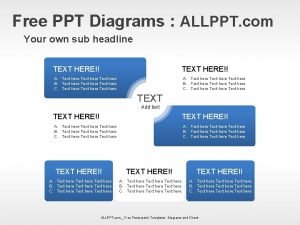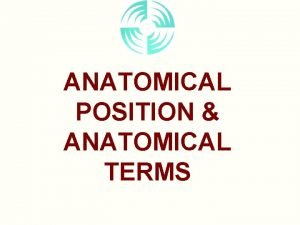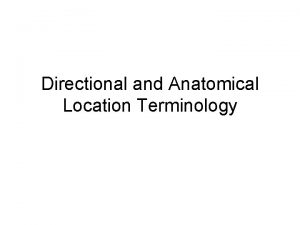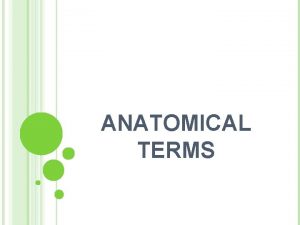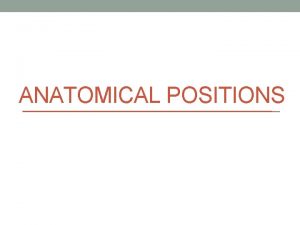Free Powerpoint Templates Page 1 Significance of anatomical



























- Slides: 27

Free Powerpoint Templates Page 1

Significance of anatomical Characters in Taxonomy By Dr. Shabnum Shaheen Free Powerpoint Templates Page 2

What are the Anatomical characters? Internal form and structure of plant organs Anatomical characters can be studied by LM SEM Free Powerpoint Templates TEM Page 3

History of Anatomy in Plant Taxonomy Nehemiah Grew (1682) Hans Solereder (1899) • The Anatomy of Plants • Systematische Anatomie der Dicotyledonen C. R. Metcalfe & • Anatomy of L. Chalk Dicotyledons (1950 ) Free Powerpoint Templates Page 4

History of Anatomy in Plant Taxonomy • Esau (1965) Endress, Bass and Gregory in 2000 Free Powerpoint Templates Rudall in 2007 Page 5

Parts of plants used as taxonomic tools 1. 2. 3. 4. 5. Wood Leaves Flower Nodes Mineral inclusions Free Powerpoint Templates Page 6

1. Wood Anatomy Wood = secondary xylem Wood is mixture of Tracheids and vessel element Fibers Free Powerpoint Templates Rays Page 7

Trends of evolution in the parts of xylem 1. Increase in F/V ration length of vessel elements = V length of tracheids (or fibre)= F F/V=1: 00 • Primitive angiosperms to 1: 20 • Most specialized F/V=4: 00 woods Free Powerpoint Templates Page 8

Trends of evolution in the parts of xylem 2. Perforation plate morphology specialization Primitive vessel Elongated and numerous scalariform perforation Advanced vessel shorter and with simple perforation Free Powerpoint Templates Page 9

Trends of evolution in the parts of xylem 3. Lateral wall specialization Scalariform pitting in Primitive plants Alternate circular pitting in Free. Advanced Powerpoint Templates plants Page 10

Trends of evolution in the parts of xylem 4. Vessel abundance Primitive Diffuse-porous wood Advanced Ring-porous wood Free Powerpoint Templates Page 11

Example of use of wood anatomy in taxonomy Specialized features of Amentiferae Primitive features of Magnoliales • Some genera of Magnoliales All members with are vesselless vessels • Vessels are long with narrow Simple perforation diameter plates • Vessels have oblique end walls • Scalariform pitting on lateral walls of vessels Ring porous wood • Scalariform perforation plates on vessels • Diffuse porous wood Free Powerpoint Templates Page 12

2. Foliar Anatomy 1. Epidermis 2. Stomata 3. Trichomes Free Powerpoint Templates Page 13

Epidermis systematically valuable characters Epidermal cell, size, shape occurrence of papillae wall thickness Free Powerpoint Templates contents Page 14

Example of use of epidermal character in taxonomy Lower epidermal cells of Sacchrum Free Powerpoint Templates Page 15

Stomata Ranunculaceous or Anomocytic stomata Rubiaceous or Paracytic Free Powerpoint Templates Page 16

Stomata Caryophyllaceous or Diacytic Cruciferous or Anisocytic Free Powerpoint Templates Page 17

Examples of use of stomatal character in taxonomy Dumbbellshaped Guard cells • Gramineae Absence of Subsidiary cells • Liliales Free Powerpoint Templates Page 18

Reliability of stomata as taxonomic tool • Lippia nodiflora is an example where all the four types of stomata have been reported to occur on the same leaf. Free Powerpoint Templates Page 19

Trichomes Family Type of trichome Malphigiaceae T shaped unicellular hairs Urticaceae Stinging hairs Bromeliaceae Scale hairs Malvaceae Stellate and tufted hairs Free Powerpoint Templates Page 20

• Comparison of two Different types of trichomes Stinging Hair Stellate trichome Free Powerpoint Templates Page 21

3. Floral Anatomy • Floral anatomy of Annonaceae, Calycanthaceae and Menispermaceae confirms that all these families originated from Ranunculaceae • Formerly Cyperaceae and Gramineae were considered in one single order. But Hutchison separated them in two different orders, Cyperales and Graminales on the basis of floral anatomical evidences. Free Powerpoint Templates Page 22

4. Nodal Anatomy Advanced Unilacunar, multiilacunar. Laurales, Caryophyllale s, Ericales Magnoliales, Piperales and Asterales. Free Powerpoint Templates Page 23

Primitive trilacunar, majority of dicotyledons Free Powerpoint Templates Page 24

5. Mineral inclusions i. Crystals Druses of Nerium oleander Raphides of Vanilla Root More common in monocotyledons dicotyledons Free Powerpoint Templates Page 25

Silica bodies are always absent in Juncaceae but always present in the family Thurniaceae. So this character can be used as taxonomic tool for identification and classification Silica bodies & the epidermis Free Powerpoint Templates Page 26 of Schizachyrium sanguineum

Free Powerpoint Templates Page 27
 Allppt free templates
Allppt free templates Alppt
Alppt Islam powerpoint template
Islam powerpoint template Slide to doc.com
Slide to doc.com Allppt template
Allppt template Freepowerpointtemplatesdesign
Freepowerpointtemplatesdesign Free real estate presentation templates
Free real estate presentation templates Allppt gratis
Allppt gratis Elearning powerpoint templates
Elearning powerpoint templates Advantages of hydroelectricity
Advantages of hydroelectricity Freepowerpointtemplatesdesign
Freepowerpointtemplatesdesign Allppt
Allppt Marketo program tokens
Marketo program tokens Powerpoim
Powerpoim Brainybetty
Brainybetty Click here to download
Click here to download Are sikhs vegetarian
Are sikhs vegetarian Slidetodoc.com
Slidetodoc.com Free call to action templates
Free call to action templates What is a running head in apa style
What is a running head in apa style Strategy map ppt
Strategy map ppt Argument vs opinion
Argument vs opinion Electromagnetic waves powerpoint template
Electromagnetic waves powerpoint template Gibbs free energy unit
Gibbs free energy unit Boltzmann entropy equation
Boltzmann entropy equation Gibbs free energy vs standard free energy
Gibbs free energy vs standard free energy The allocation map
The allocation map Helmholtz free energy and gibbs free energy
Helmholtz free energy and gibbs free energy











